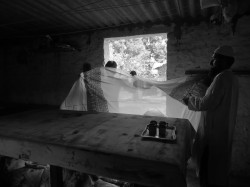 “Think moonless, think midnight, think darkness… the star spangled sky, against a stark blue-black background. This is what ajrakh, meaning blue in Arabic, is likened to.” This line from an article in the Hindu, gives a fitting visual for someone who is unfamiliar with this art form. “The word” the article states “could have come from “aaj rakh” (keep it for the day), the longer the wait between each process, the finer the result.” The process itself can be anywhere between 12 and 23 steps. Much patience and sophistication is needed in the art of ajrakh printing.
“Think moonless, think midnight, think darkness… the star spangled sky, against a stark blue-black background. This is what ajrakh, meaning blue in Arabic, is likened to.” This line from an article in the Hindu, gives a fitting visual for someone who is unfamiliar with this art form. “The word” the article states “could have come from “aaj rakh” (keep it for the day), the longer the wait between each process, the finer the result.” The process itself can be anywhere between 12 and 23 steps. Much patience and sophistication is needed in the art of ajrakh printing.
http://www.thehindu.com/features/magazine/brilliance-of-ajrakh/article883961.ece
I have had the fortune of visiting the Khatri family in Kutch a couple times now. The Khatri family migrated from Sindh about 400 years ago. They have been mastering the art of ajrakh printing ever since then. The art was passed down to Dr. Ismail Khatri from his father, who is passing the skills down to his own sons.
I woke up as the sun was rising on the Kutch Express and sleepily watched the arid terrain pass by my window. Women in their brightly embroidered skirts and blouses were beginning their day, waiting their turn at the water pump. Children stared, sleep still clinging to their eyes as the blue train broke up the brown canvas that is the landscape.
I arbitrarily chose one of the many rickshaw drivers offering me a ride and after negotiating a price, hopped in. The rickshaw turned off the paved road on to a dusty side road. I recognized this road and the boys washing cloth in rectangular pools under the early morning sun. We followed a bend in the road and The Khatri home came in to view, a subtle green color with Dr. Ismail Khatri’s sign hanging on the door.
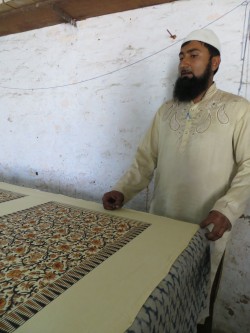 I exited the rickshaw and entered the sales area of the compound. Fabric lay in bundles on the floor. Two men folding cloth motioned in a certain direction, so I went. I walked in to a little courtyard and poked my head in the door of the living area. The women were inside preparing food. A little boy came running out to lead me to Sufiyanbhai, one of Dr Ismail’s sons.
I exited the rickshaw and entered the sales area of the compound. Fabric lay in bundles on the floor. Two men folding cloth motioned in a certain direction, so I went. I walked in to a little courtyard and poked my head in the door of the living area. The women were inside preparing food. A little boy came running out to lead me to Sufiyanbhai, one of Dr Ismail’s sons.
Inside the building were long tables covered in white cloth, stained from the many dyes used in printing, lining the rectangular room. Men busy at work were dipping the block prints in to the dye and, with remarkable precision, stamping them onto the cloth, creating a textile masterpiece one block at a time.
As the notion of being “green” is proliferating around the globe, it is important to take a step back and give credit to one of the oldest eco-friendly methods of creating patterned fabric. Ajrakh dates back to 1250-1150 BC from civilizations inhabiting the Indus Valley. Pomegranate, turmeric, indigo, camel dung, mustard seeds, iron, kesu flower; the list of natural ingredients involved is endless. Mixing the complex combinations required to produce specific colors is truly an art that takes many years to master. Dr. Ismail explained that his father used to test the quality of the dye by tasting it. The taste of the color red, for example, is chili and alum. The balance of the flavors indicates a good dye.
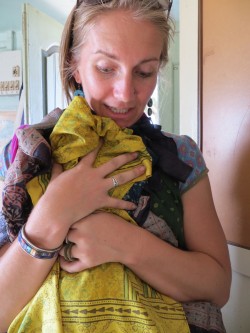 Back in the workshop, Sufiyan and I began discussing the particulars of what I had in mind. In my head, the design and colors seemed simple, cut and dry. Little did I know how complex the production would be. For a woman who is not particularly good at making decisions, I had a whole slew of them ahead of me. First, the fabric had to be chosen from many types of silk, cotton, chiffon. After much deliberation I decided on the cotton and silk blend. So soft and, well, silky.
Back in the workshop, Sufiyan and I began discussing the particulars of what I had in mind. In my head, the design and colors seemed simple, cut and dry. Little did I know how complex the production would be. For a woman who is not particularly good at making decisions, I had a whole slew of them ahead of me. First, the fabric had to be chosen from many types of silk, cotton, chiffon. After much deliberation I decided on the cotton and silk blend. So soft and, well, silky.
Next, choosing from the plethora of hand carved wooden block prints lining the shelves around the room. Endless possible combinations present themselves. I choose a few that catch my eye. The man in charge of the block printing itself is mute and deaf. I slowly pick up on the sign language being exchanged between him and Sufiyan and begin gesturing along with them. For red, you point to your tongue, white, your teeth. For black color, you point to your hair. I smiled to myself, because my hair is yellow.
At 1:00, as everyone stopped for lunch, I was invited in to the Khatri residence to eat a home cooked meal from Sufiyan’s wife. Sufiyan laid down an intricately printed blanket on the floor for us to sit on. His wife first brought out a coconut sweet, which melted in my mouth. It was out of this world. She then served rice, potatoes, dal, and roti. To wash it all down she poured me a bowl of buttermilk with fresh coriander.
After thanking Sufiyan’s wife for lunch, we proceed back to the workshop. I walk by men hanging different colored fabric out on the grass to dry in the sun. Back to business. I sit down with Sufiyan and we talk more about the scarves; the designs, colors, dimensions. The atmosphere in the workshop is so calm, zen-like, the men smiling and conversing while they create their masterpieces. Being from the Northeast region of the USA, I tend to move in the fast track and want everyone else on that track with me. Spending the day with Sufiyan and his family, printers included, caused me to slow down and take a deep breath. When we run in the fast track, we often miss the beauty in sharing a cup of chai with new friends, making decisions slowly, with intention, and a peacefulness only found when living in the present.
It was exciting to watch my creations come to life. In a couple months, the scarves will be shipped to the USA and will carry with them the long history and tradition of an art that has been passed down through the generations for the past 400 years. I hope they also carry some of the patience and peacefulness of the people who made them.
I will end with a quote from Kurt Vonnegut, introduced to me by a friend,
“Practicing an art, no matter how well or badly, is a way to make your soul grow, for heaven’s sake. Sing in the shower. Dance to the radio. Tell stories. Write a poem to a friend, even a lousy poem. Do it as well as you possibly can. You will get an enormous reward. You will have created something.”

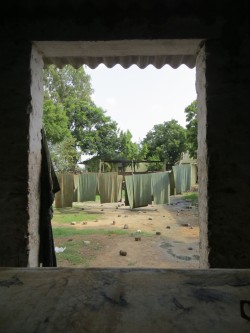
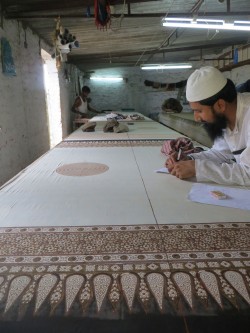
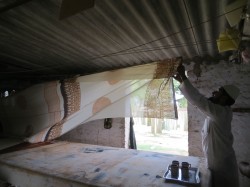
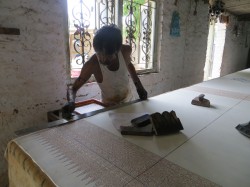
Leave a Reply
You must be logged in to post a comment.